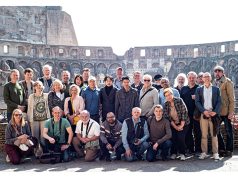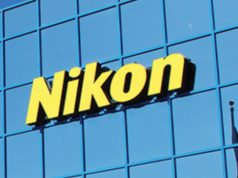Joe Adachi has had a long and illustrious career with Canon, joining the company in 1970 and working at Canon Canada and Canon USA from 1978 through 1992. He returned to Canon Inc.’s Tokyo headquarters in 1992 to work for the Photo Products group, where his roles and responsibilities continued to expand; in 1997 he was promoted to deputy group executive of the Photo Products group for Canon Inc. In 1998, Adachi was named president of Canon Canada, where he led the company through the transition from analog to digital products and revitalized the distribution channels for its office imaging systems operation. Adachi was appointed president and CEO of Canon China in 2001, leading Canon’s Asian operations during a time of tremendous growth throughout the region. Adachi rejoined Canon USA in 2005 to take the helm as president and CEO, overseeing operations for all Canon America companies and strengthening the company’s position as an imaging industry leader.
I had a chance to sit with Adachi to talk about the tumultuous past year, Canon’s outlook on the future of technology, and the progress of Canon’s new headquarters.
JG: It’s been a difficult year in the imaging business. How did Canon fare?
JA: As you can imagine, the earthquake and tsunami in Japan seriously affected our supply chain management; however, we are fortunate, because our factories were spared. Most of our supply chain problems stemmed from parts supply rather than manufacturing. So, overall, Canon quickly recovered much faster than we expected, and we showed good progress in the second half of 2011.
When something like this happens, does it change the way Canon looks to do business? No one was really prepared for it.
JA: Of course we must always learn from history, and from a business perspective we have learned a lot from this natural disaster. As we move forward and when we plan our buildings and our facilities, we are much more concerned about things like durability and location. These factors also come into focus when we look at parts suppliers. You can see the business implications happening again with the devastation that resulted from the floods in Thailand. In the wake of this tragedy, over 450 Japanese manufacturers were again seriously affected.
Was Canon affected in Thailand?
JA: Yes, we have several major inkjet factories located in Thailand that were affected. But fortunately, we had planned to open a new factory in the northern part of Thailand that just opened this past October. Northern Thailand was not affected by the flood, and we were very lucky to be able to shift some of the production lines to the new factory with minimal interruption. Further shifts in production to our factories in Vietnam also helped Canon cope with the disaster with minimal supply interruption. Although, we have experienced some lack of supply with inkjet printer products.
What do you think the real strengths are of the Canon brand? What does Canon really stand for?
JA: Canon’s unique differentiating factor and brand strength derives from our diverse product portfolio and innovative technologies of both input and output devices. Our input devices include our digital SLR and point-and-shoot cameras, our professional and consumer camcorders, our new professional cinematography cameras, our personal and business scanners as well as products like broadcast lenses and medical equipment.
Then we have output devices like inkjet printers, copy machines, laser printers, production presses and large-format printers. In all of our product categories Canon has end-to-end solutions all centered around imaging. Our input-to-output expertise is what sets Canon apart from our competitors. It is also important to recognize that Canon’s brand recognition extends beyond consumers. For example, the cutting-edge semiconductor steppers we produce cost roughly $40 million each; they require an extremely high level of technical expertise, and the production of that equipment helps Canon establish strong brand recognition in highly prestigious, extremely technical markets.
That is very important for us as a company. If we only concentrate on consumer markets and technologies, we would not enjoy our strong reputation as a brand. As a leading technology innovator, we are consistently one of the top five patent holders in the United States, and that level of expertise not only helps us capture the consumer mindshare but also niche arenas in need of high-tech solutions. So, as a brand and as a company, we are in a unique position not only on the consumer level but also in the advanced industrial technology markets.
Very, very few companies have such a variety of highly regarded technologies in as many areas as Canon does.
So you consider Canon primarily a technology company?
JA: We are first and foremost an imaging company; however, we must always be a technically driven company. And technology continues to evolve, particularly in the last 20 years. Since digital technology opened the door to every kind of industry, what’s happening is that we are seeing things as borderless now. In the 1970s and ’80s, economies really globalized. However, now technology has opened the door and removed borders between industries and between organizations.
Technology has brought change to lifestyles as well. Today, staying at home, kids can easily find friends over the Internet—international friends. The pattern of that life and communication is due to the development of technology. Today, compared to the ’80s, there are no borders. You can get access to the other side of the earth with just a few clicks of a device.
Canon is a different company than it was even five years ago. What are the priorities going forward over the next five or 10 years?
JA: As I said, the trend is borderless—not just among technologies but among lifestyles. Unless we as a company continually have wider ranges of technology, how can we survive the next five or 10 years? The key word is integration, device to device. So that’s why I believe our position at Canon is very strong for the future. The key is how we can integrate these different technologies to the common direction.
On the consumer level, integratration in the home, where there are so many different devices, can be a little confusing for consumers, as to how to pull it all together. Something as simple as getting a picture from my camera onto on my TV, or printing it or sending, it can almost be overwhelming.
JA: Exactly. That’s why you have to carefully think about that. Our lifestyle is very convenient now. You can get any information through tablets or screens or phones. We were very shocked at the first Middle East political protests this past spring, as we were able to watch it all unfold in our living rooms and spill out over social networks. It was unbelievable. CNN’s images are immediately transmitted to the average home, but what was remarkable was reading and seeing an average protestor tweeting and blogging and posting photographs from the heart of the events.
Technologies are developing at an incredible pace. That’s why it’s very difficult to predict the future. However, we recognize that there are many opportunities.
In the past, only select people with access to specific resources could accomplish certain things. Today, knowledge and information is so accessible—and the ability to show your talents is so achievable—through these amazing technologies. Look at the recent social movements across the globe; one person asked another people to come to the same place through technology, and power is born.
The smartphone has become almost the ubiquitous phone for everybody, and the cameras are getting better and better. Do you see this starting to hurt the camera business?
JA: Yes I do. I’m too honest. In an interview like this, I should say no. But we have to understand what’s happening in the market. If we close our eyes, we will make much tougher mistakes. So, yes. Cameras are not independent from other networks. Network information is affecting every kind of area; lifestyle, economy. So without networks, we can’t live. If you live by yourself, you’ll be very isolated.
Today, if you take a look at what young people are doing, they have access to everything they want. In that sense, the world is becoming more equalized; technology is doing this. That’s why even though you focus on the camera, we are not an exceptional case at all.
How did Steve Jobs affect Canon, and your business?
JA: Directly, not much. However, his concepts affected us particularly, and his ideas had a big influence for our management. What he did, if we carefully analyze it, was amazing. Over the last few years, we collected a lot of information about Apple and Jobs, and we learned a lot. Few people can really recognize what he did behind the scenes.
For example, the iPad. You will notice you cannot just open the iPad and look inside. However, if you did look at the inside, it’s well designed and delivers amazing color. So, why did he stick to the idea that no one should open the iPad? He gave equal care and quality to what you don’t see as well as what you do see.
If he was average management, he would say: make it low cost, as low as possible. But what he did inside the iPad, I believe, is spent a lot of money, and there is a reason why he did that. After it’s returned, it’s easy to fix for the service people. If the design is messy, it’s difficult to handle.
Also, what he said is very encouraging to hardware companies. The best solutions require the best hardware, and that’s what he used. If you look at the balance sheet, Apple computer does not ask OEM manufacturers to produce all of the equipment. With Apple, they go to each high-tech parts supplier, the best of the best, to find the best parts.
One more example, the display on the iPad is amazing. The coating on the surface—there are very special suppliers, and the cost is high. However, it gives you a very, very sharp image, and no matter how many times you push the display, it does not damage it. The durability is high, as is sharp image quality. But technology-wise, there’s nothing really new. But where he could save money, he would, such as moving production to China. Today, more than 40 million units are selling worldwide. Once it reaches more than 10 million units, no one can complete.
iCloud does not require a PC, so three major devices introduced by Apple have direct access to the iCloud system: iPad, iPod and the iPhone. He predicted that each device should be separated but at the same time integrated. He already planned and designed these devices almost 10 years ago, and set up a schedule for years into the future. All in all, he was an amazing businessman who had an amazing ability to understand the possibilities of technology. He was a very, very smart person.
So Canon can learn from him?
JA: Any company can learn from him. He opened new doors to the world, particularly for young people, in terms of the networking possibilities of their future.
And his retail concepts were incredible. It seems like camera retailers keep doing a lot of the same things. How do you think retailers should change?
JA: You have to understand that the average consumer needs lower prices and high tech, which they can get anywhere. So, the key challenge for retailers is how to capture people’s minds. Apple has already figured it out. How can we capture people’s minds? It’s not always the lower price; it’s understanding consumers and what is important to them. We have to understand their lifestyle, and adapt to them. Time/value is important to people. No matter what technologies we have, there is one item we cannot change: you can’t buy time. So that’s a point; no matter where you are, rich or poor, any age, one second is one second.
The best way to capture people’s minds, which is the cornerstone of the retail store, is face-to-face. Technology is good, but human interaction is key. Retailers need face-to-face contact, and while companies like Amazon might be able to deliver products more efficiently, they can never replace the human contact that is critical. Apple has done this with its stores, which are based on interaction.
Tell us about Canon’s new headquarters.
JA: Our key catch phrase for the site is the “Green Campus.” We developed many ideas. We now are aiming to be the first company to achieve the Gold status of LEED. But to do that, we have to design to save energy. For example, the new headquarters will have a capacity of around 3,000 people, almost double of what we have today. But, if we park cars on the ground for 3,000 people, that would be a lot of cars—and would potentially cover 70% of our site, so that wouldn’t be very green. So we decided, at a huge cost, to build a garage for 2,500 cars, three stories high, on two sides of the central building. So about 80% of the grounds will remain a green area.
We put many ideas into the facility. We will install wind-power generators to symbolize that we’re generating and utilizing clean energy. We will have two ponds and lots of green trees on the grounds, and we would like to open our campus to the public to enjoy it once or twice a year. We want to show how we are saving energy, and contributing back to the environment. And our employees should be proud of that.
So what does the future look like?
JA: The future is about networking. It’s not about single devices, but how devices will be used together. Two, three, four devices. And we have to help educate people to understand how their lives will be better through the new technologies that are available to them. We also need to get the R&D people out of their laboratories and into the real world, to understand how humans and technology interact. And we must continue to innovate, for innovation is the key to our future success.





